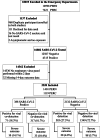Respiratory Viral Co-infection in SARS-CoV-2-Infected Children During the Early and Late Pandemic Periods
- PMID: 40063967
- PMCID: PMC11888838
- DOI: 10.1097/INF.0000000000004623
Respiratory Viral Co-infection in SARS-CoV-2-Infected Children During the Early and Late Pandemic Periods
Abstract
Background: Knowledge regarding the impact of respiratory pathogen co-infection in severe acute respiratory syndrome coronavirus 2 (SARS-CoV-2)-infected children seeking emergency department care is limited, specifically as it relates to the association between SARS-CoV-2 viral co-infection and disease severity and factors associated with co-infection.
Methods: This secondary analysis included data from 2 prospective cohort studies conducted between March 2020 and February 2022 that included children <18 years of age tested for SARS-CoV-2 infection along with additional respiratory viruses in a participating emergency department. Outcomes included the detection rate of other respiratory viruses and the occurrence of severe outcomes (ie, intensive interventions, severe organ impairment and death).
Results: We included 2520 participants, of whom 388 (15.4%) were SARS-CoV-2-positive. Detection of additional respiratory viruses occurred in 18.3% (71/388) of SARS-CoV-2-positive children, with rhinovirus/enterovirus being most frequently detected (42/388; 10.8%). In multivariable analyses (adjusted odds ratio and 95% confidence interval), among SARS-CoV-2-positive children, detection of another respiratory virus was not associated with severe outcomes [1.74 (0.80-3.79)], but detection of rhinovirus/enterovirus [vs. isolated SARS-CoV-2 detection 3.56 (1.49-8.51)] and having any preexisting chronic medical condition [2.15 (1.06-4.36)] were associated with severe outcomes. Among SARS-CoV-2-positive children, characteristics independently associated with an increased odds of any other viral co-infection included: age and delta variant infection.
Conclusions: Approximately 1 in 5 children infected with SARS-CoV-2 had co-infection with another respiratory virus, and co-infection with rhinovirus/enterovirus was associated with severe outcomes. When public health restrictions were relaxed, co-infections increased.
Copyright © 2024 The Author(s). Published by Wolters Kluwer Health, Inc.
Figures


References
-
- Mandelia Y, Procop GW, Richter SS, et al. . Dynamics and predisposition of respiratory viral co-infections in children and adults. Clin Microbiol Infect. 2021;27:631.e1–631.e6. - PubMed
-
- Guerrier G, Goyet S, Chheng ET, et al. . Acute viral lower respiratory tract infections in Cambodian children: clinical and epidemiologic characteristics. Pediatr Infect Dis J. 2013;32:e8–13. - PubMed
MeSH terms
Grants and funding
- Immunization Partnership Fund (Emerging Issues Fund) and their Emerging Issues Fund (Enhanced Surveillance)/Public Health Agency of Canada
- Operating Grant: Emerging COVID 19 Research Gaps and Priorities Funding Opportunity and Operating Grant: COVID-19 â€" Clinical Management/Canadian Institute of Health Research
- Alberta Health Services â€" University of Calgary â€" Clinical Research Fund/alberta health services
- COVID-19 Research Accelerator Funding Track (CRAFT) Program/University of California, Davis
- Eyes-High Post-Doctoral Research Fund/University of Calgary
LinkOut - more resources
Full Text Sources
Medical
Miscellaneous

